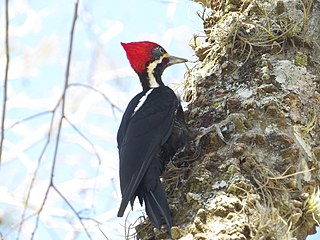
Caique refers to two to four species of parrots in the genus Pionites endemic to the Amazon Basin in South America.

The lineated woodpecker is a very large woodpecker which is a resident breeding bird from southern Mexico to northern Argentina and Trinidad in the Caribbean.

The white-bellied woodpecker or great black woodpecker is a woodpecker species inhabiting evergreen forests in tropical Indian subcontinent and Southeast Asia. It is among the largest of the Asiatic woodpeckers and nests in large dead trees, often beside rivers. It has 14 subspecies, and many of its island forms are endangered, some are extinct. Populations differ in the distribution and extent of white. Its drums and calls are louder than those of the smaller woodpeckers.

The white woodpecker is a South American species of woodpecker native to the wooded grasslands of Suriname, French Guiana, Brazil, Bolivia, Paraguay, Uruguay and Argentina. It is a bright white bird with black wings and a distinctive small bright yellow eye patch. The IUCN has rated it as a "least-concern species".

The ferruginous partridge is a species of bird in the family Phasianidae. It belongs to the monotypical genus Caloperdix. It is found in Indonesia, Malaysia, Myanmar, and Thailand.

The Apo myna is a species of starling in the starling family Sturnidae. The species is also known as the Mount Apo starling or the Mount Apo king starling. It is the only member of the genus Goodfellowia. It is endemic to the Philippines found only in the tropical montane forests of Mindanao. It is threatened by habitat loss.

The short-legged ground roller is a species of bird in the ground roller family Brachypteraciidae. It is the only living species in the genus Brachypteracias and is endemic to Madagascar. It is threatened by habitat loss.

The keel-billed motmot is a species of bird in the motmot family Momotidae. It is very closely related to the broad-billed motmot, and the two may be the same species. The two are similar sizes and shapes, and have been reported to have similar calls, but they do have different plumage.

The beautiful jay is a species of bird in the crow and jay family Corvidae. It is closely related to the azure-hooded jay, and the two species are considered sister species. The species is monotypic, having no subspecies. The specific name for the beautiful jay, pulchra, is Latin for "beautiful".

The chestnut-naped forktail is a species of bird in the flycatcher and chat family Muscicapidae. The species is monotypic, having no subspecies. It is found in Sundaland, in southern Burma and Thailand to Peninsular Malaysia, as well as Sumatra and Borneo. The species is not migratory.

The lesser hornero is a species of bird in the ovenbird family Furnariidae. It is closely related to the Pale-legged hornero, and their global distribution overlaps somewhat. This species is monotypic, meaning there is only one subspecies.

The streak-breasted fantail is a species of bird in the family Rhipiduridae. It is endemic to Indonesia, where it occurs in Seram Island. Its natural habitats are subtropical or tropical moist lowland forests and subtropical or tropical moist montane forests.

Lafresnaye's vanga is a species of bird in the vanga family Vangidae. The species is monotypic and one of three species in the genus Xenopirostris. It is endemic to the south and south west of Madagascar. It inhabits sub-arid thorn scrub, in the Madagascar spiny forests ecoregion, particularly areas with large amounts of dead wood, from sea level to 100 m (330 ft). The species has a small range is not common within that range. It was uplisted from Least Concern to Near Threatened in 2022 as it is experiencing moderately rapid population decline owing to habitat degradation and loss within its range.

The black-bodied woodpecker is a Near Threatened species of bird in subfamily Picinae of the woodpecker family Picidae. It is found in Argentina, Bolivia, and Paraguay.

The golden-naped barbet is a member of the family Megalaimidae. It is found in Indonesia and Malaysia, where it is endemic to the island of Borneo. Its natural habitats are subtropical or tropical moist lowland forest and subtropical or tropical moist montane forest.

The golden-naped woodpecker is a species of bird in the woodpecker family Picidae. The species is very closely related to the beautiful woodpecker, which is sometimes treated as the same species. The two species, along with several other species, are sometimes placed in the genus Tripsurus.

The ashy woodpecker is a species of bird in the woodpecker family Picidae. It is endemic to Sulawesi and surrounding islands in Indonesia. There are two subspecies, the nominate race M. f. fulvus, which is found in northern Sulawesi, the islands of Lembeh and Manterawu, and the archipelagos of Togian and Banggai; and M. f. wallacei, from southern Sulawesi and the islands of Muna and Buton. The second subspecies is named for the collector and scientist Alfred Russel Wallace.

The white-spotted woodpecker is a species of bird in subfamily Picinae of the woodpecker family Picidae. It is found in Argentina, Brazil, Paraguay, and Uruguay.

The melancholy woodpecker is a species of woodpecker. It is found in West Africa from Sierra Leone east to Nigeria, living in forests, forest edges, clearings and woodlands. It is sometimes considered to be a subspecies of the Gabon woodpecker. The International Union for Conservation of Nature has assessed it as a least-concern species.

Esacus is a genus of bird in the stone-curlew family Burhinidae. The genus is distributed from Pakistan and India to Australia. It contains two species, the great stone-curlew and the beach stone-curlew.





















